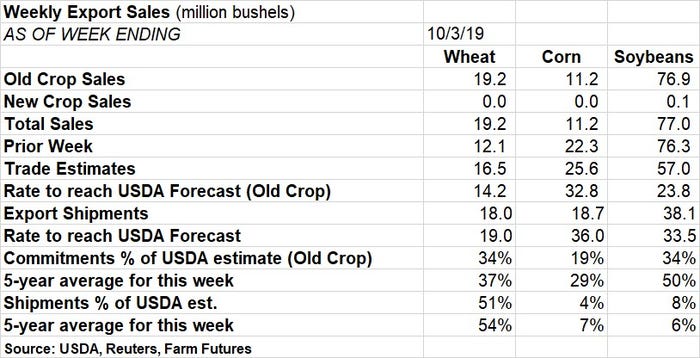
The latest round of export sales data from USDA, out Thursday morning and covering the week ending October 3, showed another strong round of sales for soybeans, with wheat also climbing higher from a week ago. Corn, meantime, slumped to less than half of the prior week’s tally and analyst estimates.

“China continues to book U.S. soybean cargoes as trade talks get underway in Washington today,” according to Farm Futures senior grain market analyst Bryce Knorr. “In addition to the 43.3 million bushels of new purchases last week, USDA also announced the sale of another 14.6 million bushels under its daily reporting system for large purchases. That brings China’s total commitments for 2019 soybeans to 191 million bushels.”
That’s an impressive total compared to last fall, when the trade war was arguably at its peak. Even so, total sales and shipments to all customers are at the lowest levels in a decade, Knorr says.
“And with China talking about a short-term trade deal that could total 1.1 billion bushels, soybean growers have a lot riding on this week’s talks,” he notes. “The key may be whether President Trump is willing to settle for an incremental process or will maintain his all-or-nothing approach.”
Total soybean sales reached 77.0 million bushels last week, climbing slightly above the prior week’s tally of 76.3 million bushels and well above analyst estimates of 57.0 million bushels. The weekly rate needed to match USDA forecasts shrank to 23.8 million bushels.
Soybean export shipments were a much more modest 38.1 million bushels, but the weekly rate needed to match USDA forecasts still moved lower, to 33.5 million bushels.
Wheat export sales also climbed higher week-over-week, to 19.2 million bushels. That was moderately above the prior week’s tally of 12.1 million bushels and ahead of trade estimates of 16.5 million bushels. The weekly rate needed to match USDA forecasts eased to 14.2 million bushels.
“Wheat sales got a much-needed boost after some disappointing totals recently, but buying was once again fragmented with our traditional customers taking relatively small mounts,” Knorr says. “Bigger crops in France and Russia will provide plenty of competition, keeping end users complacent unless weather hurts seeding in Europe and the Black Sea region. This week’s snow from the northern Plains into the Canadian Prairies could also put a premium on high protein wheat.”
Wheat export shipments were also solid, with another 18.0 million bushels, but the weekly rate needed to match USDA forecasts still inched higher, to 19.0 million bushels.
Corn export sales tumbled to nearly half of the prior week’s tally of 22.3 million bushels after notching just 11.2 million bushels last week. That was also well below the average trade estimate of 25.6 million bushels. The weekly rate needed to reach USDA forecasts moved higher, to 32.8 million bushels.
“Corn business remains very sluggish as buyers wait to see how much U.S. farmers will produce,” Knorr says. “For now, they’re content to satisfy their needs out of South America, keeping demand poor.”
Corn export shipments were also sluggish last week, reaching only 18.7 million bushels and moving the weekly rate needed to match USDA forecasts up to 36.0 million bushels.
Click here for a look at USDA’s full grain export sales report for the week ending October 3.
About the Author(s)
You May Also Like






